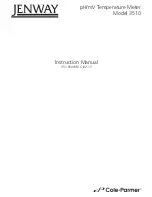
3) Insert the plug with the positive polarity in the
positive socket and the negative polarity in the
negative socket.
4 Connect the measurement end of the thermo-
couple on the temperature measurement point.
The measured value is shown on the display.
H. FREQUENCY MEASUREMENT
(see figure 10)
Warning :
To avoid harm to you or damages to the Meter, do
not attempt to measure voltages higher than 60V in
DC or 30V rms in AC although reading may be
obtained.
When the frequency signal to be tested is higher
than 30V rms, the Meter cannot guarantee
accuracy of the measurement.
(figure 10)
!
Red
Black
~
V
W
CAP
NPN
PNP °C
m
A
mA
10A
CE
OFF
OFF
Hz
SELECT
RANGE
HOLD
Hz/DUTY
hFE
FUSED
10A/15SEC.
MAX
400mA
1000V MAX
V mA
W
COM
10A
207 MK-1(T)
399.9
E
E B C
~
~
~
~
!
!
22
Caution :
n
Never connect high voltage to the input
sockets with the switch in Capacitance range.
n
Using Capacitance measurement function in a
Live
circuit will produce false results and may
damage the instrument. In many cases the
suspect component must be disconnected from
the circuit to obtain an accurate reading.
G. TEMPERATURE MEASUREMENT
(see figure 9)
Temperature measurement range is from - 20
°
C to
750
°
C.
To measure temperature, connect the Meter as
follows :
1)
Set the function switch on the “
°C”
m
easurement position.
2)
Insert the thermocouple plug into the meter’s
temperature socket.
V
W
CAP
NPN
PNP °C
m
A
mA
10A
CE
OFF
OFF
Hz
SELECT
RANGE
HOLD
Hz/DUTY
hFE
FUSED
10A/15SEC.
MAX
400mA
1000V MAX
V mA
W
COM
10A
207 MK-1(T)
399.9
E
E B C
~
~
~
~
!
!
(figure 9)
Temperature Probe
21


































